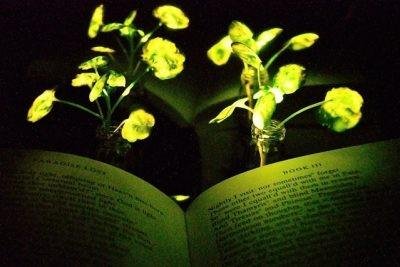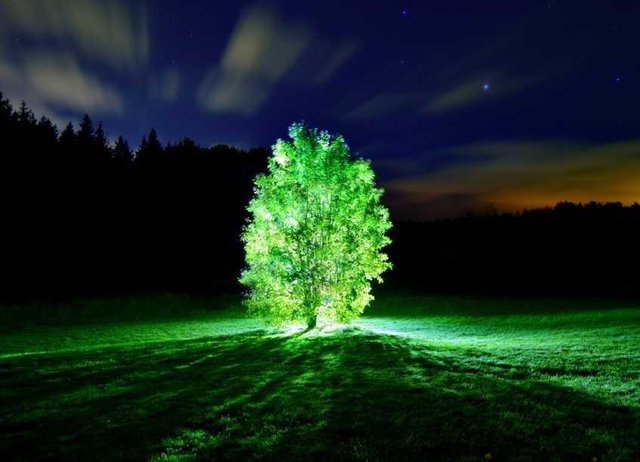What I learnt this week 4 (Part2): The glowing plant.
Err.... This is the concluding part of WILTW 4. I thought this was too much to put down in 3 or 4 paragraphs. Although, I could have done it, I thought it would be better if I took my time to go into it well enough to give people a better knowledge of it.
Friday: The Glowing Plant
This is an amazing discovery. The glowing plant is not "completely novel" but it is surely novel. At a point where we need to put on our lamps for illumination around the house or at a point, we need to read for an urgent interview or exam and there is a power outage, a glowing plant is very useful-it's bright enough to illuminate a room if positioned well. My fellow Nigerians can testify to the irregularity of power supply in Nigeria so there's no need to talk much.
The glowing plant was discovered by the engineers at MIT when they embedded some "specialized nanoparticles" into the leaves of some watercress plant inducing it to give off dim lights as in the picture below for about 4 hours. The engineers believe that by optimizing the nanoparticles further, greater light could be produced which the above image has already proven.

These glowing plants can be used to provide light of low intensity for the home at least they will reduce the number of electrical devices we have in our homes.
Plant Nanobionics
Plant nanobionics is a new field of research pioneered by the Strano's lab. Currently. their aim is to give novel features or power to plants by embedding them with the various types of nanoparticles they are able to get. Sometimes, the result of embedding the particles might not be known but the experiments are meant to bring further discoveries in the future. Another of their aim is to reduce the number of electrical devices we have drastically. How is that possible? Don't be surprised they already made plants that detect explosives and pass the information to a smartphone and "plants that can monitor drought conditions."
The glowing plant is a low-energy power source that can be used to lighten up a workstation or used as a reading lamp. There is no need for electricity to recharge or anything and the lighting "accounts for about 20 percent of worldwide energy consumption." Apart from the energy consumption aspect, the plants know how to repair themselves, and can be used in outdoor environments.
Lest I forget, if you remember I said this discovery is not completely novel and later I mentioned specialized nanoparticles, this is because the nanoparticles supply the plant with luciferase, an enzyme we already know. In case you don't know, luciferase is responsible for the lights in the butt of the fireflies. What the Luciferase does is that as an enzyme, it acts on the molecule luciferin to emit light. There is another molecule said to help the process by removing a byproduct of the reaction between luciferase and luciferin. The byproduct the molecule removes is said to curb the activity of luciferase and the molecule is called "coenzyme A"
At the Strano's lab, silica nanoparticles of 10 nanometers diameter were used to carry Luciferase, a little bit larger particle of the polymer PLGA was used to carry the Luciferin, and a little bit larger particle of the polymer chitosan was used to carry the co-enzyme A. When it was time to get the nanoparticles into the plants, they immersed the plants in a solution containing the particles. Then, they exposed the solution to high pressure causing the pores (stomata) of plants to open and allow the nanoparticles in.
Particles releasing luciferin and coenzyme A were designed to accumulate in the extracellular space of the mesophyll, an inner layer of the leaf, while the smaller particles carrying luciferase enter the cells that make up the mesophyll. The PLGA particles gradually release luciferin, which then enters the plant cells, where luciferase performs the chemical reaction that makes luciferin glow.
At first, the glow lasted for about 45 minutes which they later worked on to have the current duration of nearly 4 hours. Scientists are currently working on improving the brightness as well as the duration of glow. So, let's watch out.
Plant transformation
Well, did I mention there had been previous tries to create a plant that glows or emits light? Yes, they were but unsuccessful. They engineered plants genetically so that they can express the genes of luciferase, it worked but the light was too dim. The experimental plants were the tobacco plants and Arabidopsis thaliana, "the most common plants used for genetic studies." On the other hand, Strano's lab was able to do their experiment on any plant at all. First, it was watercress, then, arugula, kale, and spinach.
The next thing in line now is the painting of nanoparticles before putting into plant leaves. I think their aim is to make trees and other plants another source of light for our streets, major roads, workstations, et cetera...
From the beginning where you started reading from till this point, did you ever think of the possibility of turning off the glow or light from the plants? Work is in progress... The researchers said the light could be turn off by adding nanoparticles that carry an inhibitor of luciferase
This could enable them to eventually create plants that shut off their light emission in response to environmental conditions such as sunlight, the researchers say.
Advantages
- It is not harmful.
- It can be easily delivered to plant tissues.
- It is highly sensitive.
Thank you for coming around!!
That little boy, @pearlumie.
Sources
MIT | Genetic Literacy Project | Nature

This guy you are really researching. I was even planning to write on this today... Ahhhhh kudos to you. Great researcher
Upv by @eurogee and the founder of @euronation Newbie's Support Team
Thank you sir...
Nice! I also saw more and more people are proposing using glowing bacteria to light up the city in dark XDD
http://www.iflscience.com/environment/bioluminescent-bacteria-could-light-streets-paris/
by the way, I am currently hosting a science picture contest with sbd and sp as award. Feel free to see if you are interested :D
https://steemit.com/sciencepic/@mcw/christmas-science-picture-challenge-1-with-sbd-and-sp-prize-1-sbd-sp
You've got a passion for science. The work you put into this is evident in the quality of post. Kudos